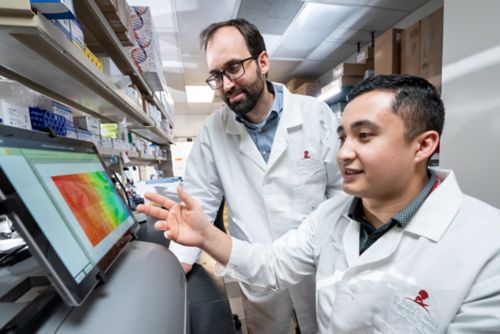St. Jude Family of Websites
Explore our cutting edge research, world-class patient care, career opportunities and more.
St. Jude Children's Research Hospital Home

- Fundraising
St. Jude Family of Websites
Explore our cutting edge research, world-class patient care, career opportunities and more.
St. Jude Children's Research Hospital Home

- Fundraising
Gain-of-function mutation reveals new target in pediatric acute myeloid leukemia
Pediatric acute myeloid leukemia (AML) accounts for 20% of all pediatric leukemia cases and is associated with poor outcomes, especially if the disease relapses. Part of the struggle with treating pediatric AML is that the current understanding and interventions stem primarily from knowledge of adult AML, which differs from pediatric disease. However, St. Jude scientists are working to change this.
Jeffery Klco, MD, PhD, Department of Pathology, and his team aim to narrow the knowledge gap and improve treatment for pediatric AML through a better mechanistic understanding of the disease.

Jeffery Klco, MD, PhD (left), and Juan Barajas, PhD (right), explored genes uniquely linked to pAML and tracked a gain-of-function mutation in one protein with therapeutic potential.
The researchers had previously categorized pediatric AML into 23 molecular subtypes, including 12 unrecognized by the World Health Organization’s classification system for AML. One such subtype associated with poor outcomes involves the gene UBTF, which encodes a critical protein for transcription. In this AML subtype, UBTF mutates by undergoing a DNA replication error called tandem duplication. These genetic duplications vary in size and lead to functional yet mutated proteins.
In earlier work examining UBTF and its role in pediatric AML, the team detected mechanistic clues that helped them uncover the role of UBTF tandem duplications.
Disease-linked proteins may be affected by loss-of-function mutations, meaning that the protein no longer works, or by gain-of-function mutations, meaning that the protein still works but in a way that differs from normal. In pediatric AML linked to UBTF tandem duplications, the researchers observed a functional UBTF protein, which indicated that a gain-of-function mechanism contributes to this subtype of pediatric AML.
The team’s research led them to HOX genes, which are dysregulated in many cancers, including UBTF–tandem duplication pediatric AML and other pediatric AML subtypes. Their findings, published in Blood, illustrate the role HOXA and HOXB gene clusters play in UBTF-linked pediatric AML.
“The models elegantly show that this mutant protein will directly bind to the HOXA and HOXB loci — the gene location on a chromosome — whereas the wild type doesn’t,” said corresponding author Klco.
The findings also uncovered two other proteins, KMT2A and menin, alongside mutated UBTF at these loci, which was unsurprising to the researchers. KMT2A, a protein involved in hematopoiesis, and menin, a protein linked to gene regulation, are often implicated in HOX-related leukemias.
By identifying UBTF–tandem duplications as a previously unrecognized target, this work can guide the development of novel treatment strategies. The researchers also demonstrated that leukemia with UBTF–tandem duplications is sensitive to menin inhibitors. Disrupting KMT2A and menin interactions affected UBTF binding to the genome, thus presenting a potential new strategy for treating UBTF–tandem duplication pediatric AML.
“This collective work offers mechanistic insights that nominate and validate a new therapeutic option,” said Klco. “It’s well known that kids with these alterations have a dismal outcome. This has an opportunity to be somewhat transformative in how these kids are treated.”